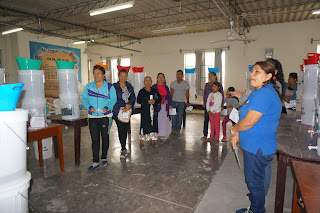In Paita, Peru, water is obtained from the Piura River, about 35 miles from Paita. The water plant chlorinates the river water, just as Milwaukee chlorinates Lake Michigan water to provide Milwaukee County with drinking water.
 |
| Piura River Provides Water to Many Municipalities |
 |
| River Water is Treated by the Water Plant in Piura |
 |
| Map of Water Plants in the State of Piura |
In May, 2015, St. Paul Parish and Milwaukee School of Engineering (MSOE) installed 25 water purifiers in Paita, Peru. After one year of trialing the Berkey Purification Systems, Sister Monica asked for more systems because the people feel it's easy to use and maintain. Each system will provide 6,000 gallons of purified water for each family receiving a system.
St. Paul Parish had enough money in their budget to provide another 50 systems. Thanks to all of our donors who made this possible. Each system requires two buckets and covers, two Berkey filters, and one spigot.
 |
| Supplies Needed to Assemble a System |
In our community here in Wisconsin, if we need supplies, we get in our car or truck and drive only miles down the street to pick up our supplies. The sisters do not have it that easy. First of all, they don't own a working vehicle. They own a 1984 Bronco and it hasn't worked in years because parts are unavailable. The buckets were purchased at a bucket supplier in Piura, Peru, about 38 miles from Paita. The sisters had to hire a driver and rent a vehicle large enough to transport the 100 buckets pictured below.
 |
| 100 Buckets and Covers |
 |
| Counting the Inventory of Buckets and Covers |
 |
| Miranda Drilling Holes into Buckets and Covers |
 |
| Emily Labeling Outside Buckets |
 |
| Miranda Cleaning Buckets After Drilling Holes |
 |
| Miranda Inserting Filters and Testing Each System |
 |
| Assembling One System |
After all systems were assembled, tested and working properly, Miranda and Charlie trained 38 people on how to assemble and maintain each system. There were three training sessions on Monday, hours before leaving for our drive to Piura to take our flight home. Charlie also trained each group on basis skills to prevent cross-contaminating food and water, washing hands, how to use chlorine and iodine to clean food and water, etc.
Forty-three systems were promised to families in some very impoverished communities. After these families receive their system and use them for a short time, a community representative will follow-up with each family. Sister Paula heads this project and works directly with the leaders in the community. For those that didn't make it to training, Sr. Paula or the leaders will train those not attending the training. There are seven systems that will be given to other families in the future.
 |
| Charlie and the First Training Session |
 |
| Mother and Baby at Training |
 |
| Charlie and Miranda |
 |
| Thank You! |
 |
| "We Appreciate These New Systems." |
 |
| Muchas Gracias! |
Submitted by Deb Passino










No comments:
Post a Comment